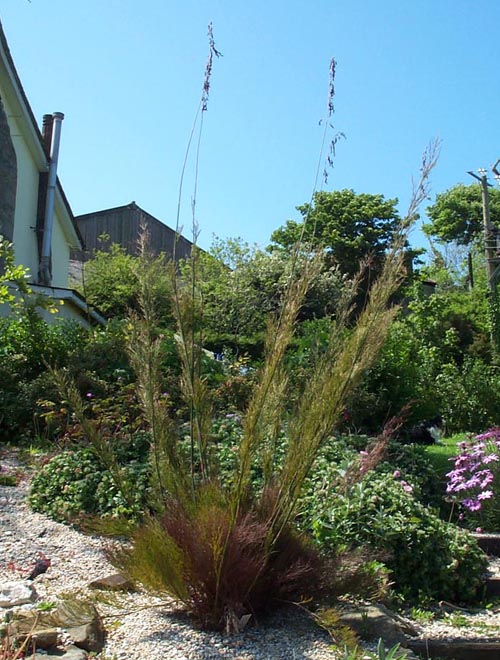Restios
A cut above the Restios

Rhodocoma gigantea
General introduction.
Graham Jeffery of Trevena Cross Nurseries in Cornwall first introduced me to this exciting range of plants in 1997. Graham is at the forefront of introducing these wonderful plants into the UK. A few people have been keen on them for a while but being notoriously difficult to germinate they have been slow to gain in popularity. Graham has spent a lot of time and effort in the process of finding a viable answer to this and is now able to offer in the region of 20 varieties for sale. I have half a dozen varieties in my own garden and cannot rate them highly enough as wonderful structural plants.
Background information.
The restionacae with their reed like foliage and often producing stems resembling a bamboo belong to a family that is mainly confined to the Southern Hemisphere and although there are members of this family to be found in several countries including New Zealand and Australia it is largely the South African varieties that are creating the most interest. Most of the species are found in the Fynbos region of the country in fact the restios account for a very large percentage of the vegetation in this region. The early settlers to this area found many uses for the restios. Varieties such as Chondropetalum tectorum and Thamnochortus insignis were traditionaly used as thatching material and this is now making a comeback on the marginal farmlands of the southern Cape. Other uses include the use of the stems in broom making such as with Elegia capensis. Many varieties make wonderful material for flower arranging using both the foliage and the dried flowering stems.
Hardiness
In the Fynbos region they are subjected to harsh growing conditions being found often growing on poor soils in exposed conditions, subjected to hot weather in the summer and often very cold weather in the winter. Many of the plants available in the United Kingdom are classed in the USDA hardiness zone as Zone 8 which means provided that they are given the right growing conditions they should take temperatures as low as minus 7 to minus 12 degrees C. We have had experience of some varieties surviving an extended minus 6 degrees with no problems at all.
Growth habit
While young plants in three litre pots do not look very striking they very quickly grow into magnificent specimens. The restios make a wonderful addition to virtually any garden with their differing growth habits and heights. Some varieties produce arching stems while others are very upright. Golden brown inflorescenses are produced on the end of the stems in the summer and the seed heads can last well into the winter. They will not self-seed so therefore will not become a problem. Some of the lower growing forms such as Restio festuciformis and Rhodocoma fruiticosa look stunning when planted in containers especially when planted in some of the wonderful range of containers available on the market today. The taller growing ones such as Rhodocoma gigantea, Calopsis paniculata and Elegia capensis make stunning specimen plants. Where space allows plant several varieties in the same border to give a really great effect with the contrasting foliage.
Cultivation.
An easy to grow range of plants, the main keys to success are to plant them in a well-drained soil that is not too rich. They do respond to the use of a slow release fertilizer if planted in very poor soils but on the whole in most normal garden situations they should not require much in the way of supplementary feeding. Growth will certainly be aided by regular watering in the summer in times of hot weather but they are able to withstand long periods of drought once established. They are all best planted in a situation where they will get full sun and the use of a mulch of bark chips or similar will help to conserve moisture in the summer and to help keep the frost away from the roots in the winter. In very cold areas it may be advisable to give them some further protection from the frost with the use of horticultural fleece.
Recommended varieties
Tall growing species to consider are; Elegia capensis growing to about 2m tall with the branches arranged on the main stem in very attractive whorls. Rhodocoma gigantea a stunning plant with stems resembling a bamboo reaching to between 2-3 m. Chondropetalum tectorum forms a lovely tufted clump of stunning foliage reaching to about 1.5 m high.
Lower growing species include Elegia grandis, Restio festuciformis, Rhodocoma fruiticosa and some of the Thamnochortus species.
Further information.
Information on this range of plants is very hard to find. However the following are useful starting points.
To find out more about this exciting range of plants contact Trevena Cross Nurseries, Breage, Helston, Cornwall TR13 9PS Telephone 01736 763880 Fax 01736 762828 email
sales@trevenacross.co.ukKirstenbosch botanical garden
www.nbi.ac.za/kirstenbosch/tourmap.htmhttp://finebushpeople.co.za/index.html
Further information is available from a book entitled "Growing Restios" This is from the Kirstenbosch gardening series and is priced at £4.95. at Trevena Cross Nurseries and Garden Centre; 01736 763880